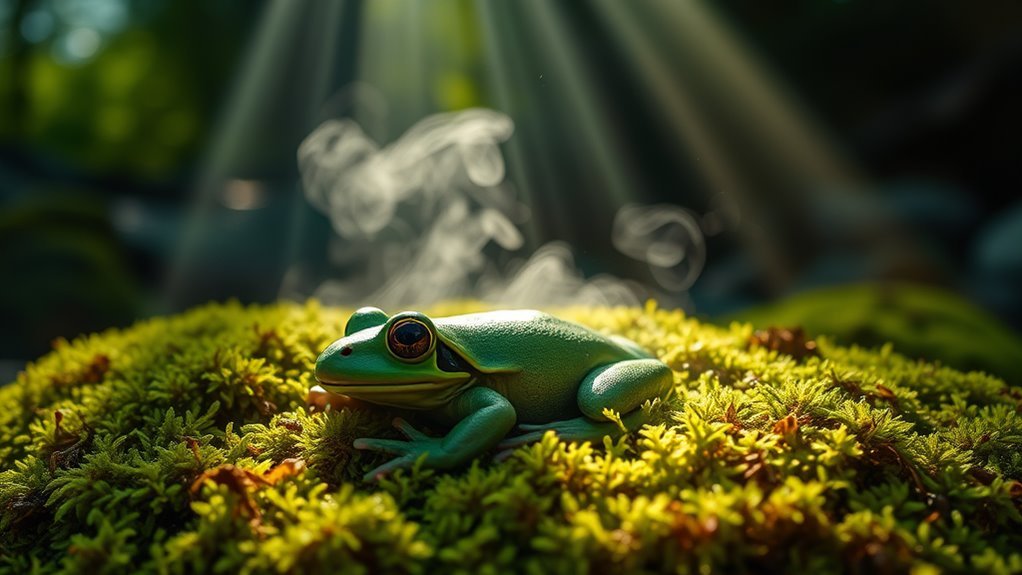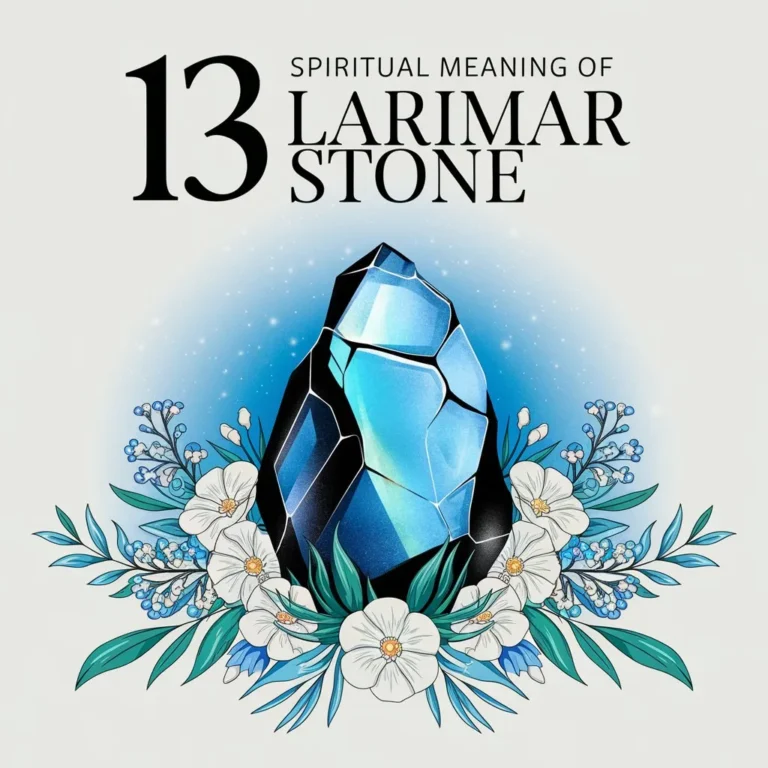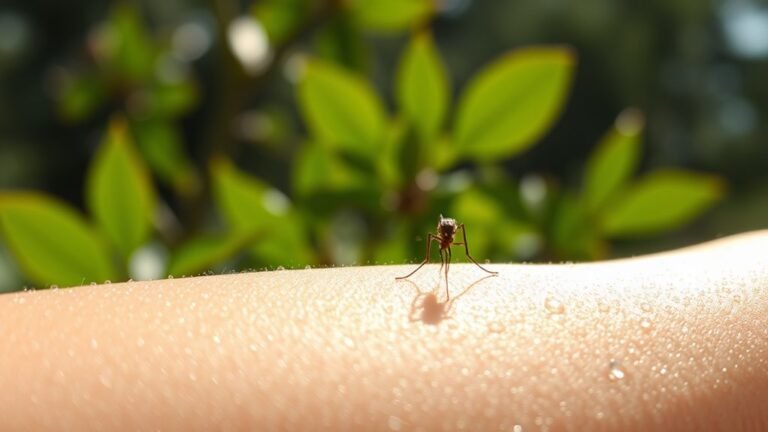10 Spiritual Meanings of a Dead Frog
As we explore the spiritual meanings behind a dead frog, we find that its symbolism offers us profound insights into transformation, letting go, and even our connection to nature. Each aspect serves as a reminder of life's fragility and the need for personal growth. But what do these messages mean for us in our everyday lives? How can we apply these lessons to foster deeper connections and embrace our own vulnerabilities? Let's consider the layers of meaning that a seemingly lifeless creature can reveal, prompting us to reflect on our paths and choices.
In a Nutshell
- A dead frog symbolizes the end of one phase and the potential for new beginnings, reflecting the cycle of life and death.
- It serves as a reminder of mortality, prompting appreciation for life's fragility and the importance of cherishing each moment.
- The lifeless frog encourages emotional healing by representing the need to let go of outdated beliefs and embrace personal transformation.
- Observing a dead frog can foster deeper connections with nature, reinforcing the understanding of life cycles and the interconnectedness of all beings.
- The presence of a dead frog may signify a need to assess one's environment, promoting gratitude and awareness of toxic influences on personal growth.
Symbol of Transformation
When we think about the frog, especially in its lifeless state, it's hard not to see it as a powerful symbol of transformation. Frogs undergo a remarkable metamorphic journey, starting as eggs, then tadpoles, and finally emerging as full-fledged creatures. This process mirrors our own personal evolution, reminding us that change is both necessary and beautiful, even when it feels uncomfortable or painful.
In observing the frog, we can reflect on our own transformations. Each stage of its life represents a chapter in our story, where we shed old skins, confront challenges, and ultimately emerge renewed. It's a reminder that every ending carries the seed of a new beginning.
When we witness the frog's stillness, we might feel the weight of our own struggles, yet we also recognize the potential that lies within us. We all yearn for belonging, and in this collective journey of growth and transformation, we find connection.
Let's embrace the lessons of the frog, celebrating our metamorphic journeys together. Through our shared experiences, we can inspire one another to embrace change, knowing that every phase brings us closer to our authentic selves.
Message of Letting Go
As we embrace the frog's journey of transformation, we soon encounter the profound message of letting go. This lesson invites us to reflect on the importance of surrendering what no longer serves us. Just as the frog must release its old skin to thrive, we too must engage in our healing process, allowing space for emotional release.
Letting go doesn't always come easily; it's often intertwined with grief and discomfort. We can find solace in recognizing that every ending is also a beginning. As we navigate our feelings, we create an opportunity to heal, shedding burdens that weigh us down. Each moment we choose to release is a step toward renewal, opening pathways for growth and connection.
Together, we can explore the beauty in this process. By supporting one another in our journeys, we cultivate a sense of belonging, where vulnerability is met with understanding.
Embracing the message of letting go helps us become lighter, more authentic versions of ourselves. So, let's take this leap, hand in hand, as we honor our past while courageously stepping into a future filled with possibility and hope.
Sign of Renewal
Renewal emerges as a powerful symbol in the life cycle of a frog, reminding us that transformation is always within reach. In nature, the frog undergoes a remarkable rebirth process, evolving from egg to tadpole to adult. This cycle reflects our own capacity for new beginnings, encouraging us to embrace change and growth in our lives.
When we witness the end of one phase, like the death of a frog, it nudges us to recognize the potential for renewal that lies ahead. It invites us to reflect on how endings can lead to fresh starts, urging us to let go of what no longer serves us.
Together, we can celebrate the beauty of this cycle, understanding that every conclusion gives way to new opportunities.
As we journey through our own transformations, let's remember the frog's story. It teaches us that rebirth isn't just an abstract concept; it's a tangible experience.
We can find solace in knowing that, just like the frog, we too can emerge renewed, ready to leap into the next chapter of our lives with hope and resilience.
Reflection on Mortality
The lifeless form of a frog can serve as a poignant reminder of our own mortality, prompting us to confront the inevitable end that awaits all living beings. In these moments of reflection, we find an opportunity for mortality awareness and life acceptance.
- Natural Sea Salt for Purification: Crafted from pure sea salt, it’s used for energy purification,...
- Ideal for Rituals & Spellwork: Use this natural sea salt in rituals like spellwork, altar...
- FOR USE IN PROTECTION & PURIFICATION RITUALS - Our Spell Breaker Bath Salts are for use in any type...
- ]HERBS & ESSENTIAL OILS - Made with Peony, Rue, Agrimony, Mint, Asafoetida, Burdock, Rosemary, Devil...
- Dragon’s Blood Infusion: Infused with Dragon’s Blood resin, this pure sea salt helps amplify...
- Versatile for Candle Magic & Spells: Boost the potency of your manifestation spells, candle rituals,...
- Natural soy 6 oz candle for cleansing negative energy
- Includes Sage, Rose, Lavender and Essential Oils in Every Candle
- Natural soy 6 oz candle for Negative Energy & People
- Includes Sage, Himalayan Crystal Salt and Essential Oils in Every Candle
Together, let's consider how this awareness can enrich our lives:
- Embrace Each Moment: Recognizing the fleeting nature of life encourages us to savor the present. Each interaction, each smile, and each shared laugh becomes precious.
- Cultivate Connections: Understanding our shared mortality fosters a deeper sense of belonging. We realize we're not alone in our struggles, and we can lean on one another for support.
- Pursue Fulfillment: Knowing that life is finite inspires us to chase our dreams and passions. We're reminded to live authentically and leave a meaningful legacy.
As we reflect on the dead frog, we're reminded of the beauty and fragility of life.
Let's honor our journey by embracing the lessons mortality offers, and in doing so, we cultivate a deeper appreciation for every heartbeat and every breath we share.
Indication of Change
In moments when we encounter the lifeless body of a frog, we can sense a deeper message about transformation and the cycles of life. This poignant symbol invites us to reflect on the changes we experience within ourselves and our surroundings. Many cultural beliefs resonate with the idea that death and rebirth are intimately connected. Just as the frog evolves from water to land, we too navigate our own seasonal shifts, embracing the inevitable transformations that come with time.
When we witness a dead frog, we might feel a gentle nudge to examine what no longer serves us. It could signal the end of a chapter, urging us to let go of outdated beliefs or relationships that hinder our growth. This moment serves as a reminder that change, although often uncomfortable, paves the way for new beginnings.
As we gather in community, sharing our experiences and insights, we create a space where we can support one another through these transformations. Together, we can honor the changes in our lives, finding strength in our collective journey toward renewal and rebirth.
Reminder of Adaptability
Encountering a dead frog can stir up a profound reminder of our own adaptability. Just as frogs shift between water and land, we too must navigate life's changes. This moment invites us to reflect on our survival skills and the harmony we aim for within our environments.
Let's consider three key aspects of adaptability that resonate with us:
- Embracing Change: Just like the frog's life cycle, we're constantly evolving. Each shift brings new opportunities for growth.
- Learning from Challenges: Frogs face numerous challenges in their habitats. Similarly, we can learn from our struggles, using them to refine our survival skills and resilience.
- Finding Balance: Frogs thrive in various environments, reminding us to seek environmental harmony. We must find our own balance, whether it's between work and home or personal and social lives.
In recognizing these lessons, we strengthen our connection to one another and the world around us. The dead frog symbolizes the importance of adaptability, urging us to embrace change while cultivating our survival skills in pursuit of a harmonious existence.
Warning of Stagnation
A dead frog serves as a stark reminder of the dangers of stagnation. It symbolizes the risk we encounter when we become complacent, allowing our lives to settle into a routine that lacks vibrancy.
We might find ourselves caught in a cycle of comfort, but this comfort can quickly suffocate our growth potential. When we neglect stagnation awareness, we risk becoming like the lifeless frog—frozen in place, unable to leap into new opportunities.
Let's reflect on how we can embrace change, even when it feels uncomfortable. Stagnation often whispers to us, lulling us into believing there's safety in sameness.
Yet, we understand deep down that life flourishes when we take risks, pursue passions, and challenge ourselves. Together, we can cultivate an environment that encourages exploration and movement, nurturing our spirits and dreams.
Invitation for Self-Reflection
The lifeless form of a frog invites us to pause and reflect on our own journeys. In this moment of stillness, we're reminded that life is a delicate balance between growth and stagnation. As we contemplate this symbol, we can commence our self-discovery journey, seeking deeper understanding and inner peace.
Let's consider a few points together:
- Embrace Change: Just as the frog undergoes transformation, we too need to embrace the changes in our lives. Each shift can lead us to greater self-awareness.
- Assess Our Environment: The frog's demise may signify a need to evaluate our surroundings. Are they nurturing our growth, or are they holding us back? By reassessing, we can create spaces that promote healing and growth.
- Cultivate Gratitude: Reflecting on what we've allows us to appreciate the journey. Acknowledging the beauty around us can foster deeper connections and a sense of belonging.
As we navigate our self-discovery journey together, let's remember the lessons that arise from moments of stillness. Through reflection, we can open pathways to inner peace and fulfillment.
Call to Embrace Emotions
In moments of reflection, we often uncover a wellspring of emotions waiting to be acknowledged. The symbolism of a dead frog invites us to confront our feelings, reminding us that emotional healing begins with embracing vulnerability. Just as the frog shifts from life to stillness, we too must honor our own emotional journeys, recognizing that it's okay to feel deeply.
When we allow ourselves to be vulnerable, we create a space for growth and understanding. Each tear shed or joy felt is a reflection of our humanity, a shared experience that connects us all. We're not alone in our struggles; the act of embracing our emotions fosters a sense of belonging that transcends isolation.
Let's encourage ourselves to explore those depths instead of skimming the surface. In doing so, we'll find that acknowledging our emotions—both light and dark—leads to profound transformation.
Together, we can nurture this emotional landscape, understanding that every feeling is valid and worthy of expression. As we embrace our vulnerabilities, we pave the way for deeper connections with ourselves and each other, creating a tapestry of shared resilience and love.
Connection to Nature's Cycles
Nature's rhythms pulse around us, echoing the cycles of life and death that define our existence. When we encounter a dead frog, it invites us to reflect on our connection to nature's rhythm and reminds us that every ending is a part of a greater cycle. These seasonal shifts teach us about renewal and transformation.
Let's explore how we can embrace this connection:
- Awareness of Change: By observing the changes in nature, we can better understand our own shifts in life. Just as the frog's life cycle evolves, so do we.
- Embracing Impermanence: Recognizing the temporary nature of all things helps us appreciate our experiences and relationships. Each moment, like the frog's life, has its own significance.
- Finding Balance: Engaging with nature allows us to find harmony within ourselves. We can learn to flow with life's rhythms, knowing that death and rebirth are intertwined.
As we reflect on the lessons that a dead frog brings, let's remember that we're all part of this beautiful, intricate dance of existence, connected through nature's cycles.
Frequently Asked Questions
What Does a Dead Frog Symbolize in Different Cultures?
When we explore cultural beliefs, we find that a dead frog evokes diverse symbolism interpretations. It often represents transformation, renewal, or loss, reminding us of the interconnectedness of life and the lessons embedded within nature's cycles.
How Can I Interpret a Dead Frog in Dreams?
When we dream of a dead frog, we should consider our personal symbolism and emotions. Through dream analysis, we can explore themes of transformation, loss, or unresolved feelings, helping us connect with our deeper selves.
Is Finding a Dead Frog Considered a Bad Omen?
We often wonder if finding a dead frog signifies bad omens. While some see it as a natural sign of change, we can reflect on its deeper meaning together, embracing transformation rather than fearing it.
What Should I Do if I Find a Dead Frog?
If we find a dead frog, let's reflect on our feelings first. Then, we can responsibly handle its disposal, perhaps burying it to honor its life, creating a moment for personal reflection and connection with nature.
Can a Dead Frog Have Specific Meanings for Different Individuals?
Absolutely, a dead frog can hold unique meanings for each of us. Our individual beliefs and personal experiences shape how we interpret such moments, inviting reflection and connection within our shared journey through life's mysteries.

Sofia Phillips is a renowned spirituality expert and the visionary behind SoulfulCreature.com. With a compassionate heart and an enlightened mind, Sofia embarks on a quest to guide others through the realms of spirituality. Her approach is deeply rooted in providing a nurturing and positive experience, allowing individuals to explore and grow in their spiritual journey.







